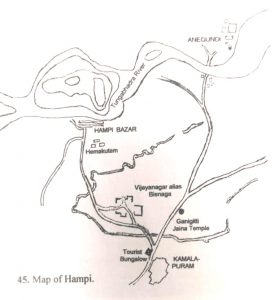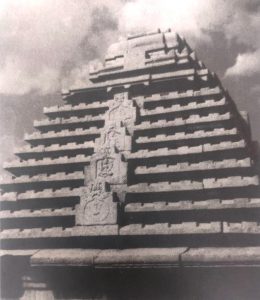Hampi
 Hampi . Jaina temple popularly known as the Ganigitti (oil woman`s) Temple. Built in 1385.
Hampi . Jaina temple popularly known as the Ganigitti (oil woman`s) Temple. Built in 1385.
In the early nineteen-eighties. Hampi (alias Vijayanagar) was adopted by young travellers from abroad as an alternative hide-out next to Goa which at that time began to be overrun by tourists. It was a sensible choice to make.
The first Portuguese of Goa were quick in establishing trade links with the rulers of Hampi. At that time-Goa was taken by the Portuguese in 1510- Hampi, the capital of the mighty Vijayanagar empire, was a fabulous rich city, and since it was known that the kings of Hampi, who originally hailed from Rajasthan, had grown fond of horses, enterprising Goan traders tried their luck in buying thorough- bred Arab horses and taking them to Hampi.
The Hindu empire of Vijayanagar, founded in 1336 as a reaction to the attempt of the Great Mughal’s forces to capture still more Hindu strongholds in the south, succeeded for over two centuries to prevent the expansion of Muslim rule into South India. Bijapur, 250 kilometres to the north of Hampi, was at that time already a Muslim sultanate (in 1320, dismantled parts of Hindu and Jaina temples were used for building one of the first mosques of Bijapur).
In 1564, mainly due to the relapse of the Hindu feudatories into their old rivalry, and a deterioration of morale among the soldiers and the general population.
Hampi was overrun and ruthlessly looted by a Muslim army from the north, and subsequently deserted by its inhabitants.
The temples, sculptures, and civil buildings which withstood the fury of war and the iconoclastic fanaticism of the time are glorious reminders of Indian art and architecture at their best, though hardly any remained unscathed.
The most valuable Jaina building among the ruins of Hampi is the Ganigitti temple built in 1385 by Iruga, a Jaina minister of king Bukka II. It is a solid, unpretentious structure, devoid of Hindu sculpture and placed rather far apart from the next group of temples, but this conforms to Jaina tradition. Annoyingly, the door of this temple is usually kept locked.
A number of other Jaina temples are situated on the barren slope of Hemakutam hill (ill. 44), conveniently close to the Hampi Bazaar which used to be the sacred area of the royal city, the stately street where the temple cars were pulled along on festival days to the sounds of music and the chants of priests.
No Jina statues have been found in these temples. Thus, the most laudable Jaina *monument’ of Hampi which has come to us may well be the words noted down in or about 1536 by the Portuguese trader Fernao Nuniz barely thirty years before the destruction of this fabulous city: “And in this kingdom,” he recorded, “there is a class of men, native of the country, namely Brahmans, who for the most part of them never kill or eat any live thing, and these are the best that there are among them.
They are honest men, given to merchandise, very acute and of much talent, very good at accounts, lean men and well-formed, but little fit for hard work. By these and by the duties they undertake the kingdom is carried on” (Filliozat 1980: 165).
 Some members of that ‘class of men- men, women and children – must have survived the slaughter of 1564/65, which means that their descendants are still with us.
Some members of that ‘class of men- men, women and children – must have survived the slaughter of 1564/65, which means that their descendants are still with us.
Crossing the Tunga- bhadra River in a round basket-boat at Talarigattu village east of Hampi, takes one to the ruined city of Anegundi. There, among its remains, are a Jaina temple and a group of standing Jinas carved on a vertical rock surface.
 Among Digambara in the south, it is quite common to think of oneself of being a lama by religion and a
Among Digambara in the south, it is quite common to think of oneself of being a lama by religion and a Brahman by class, if this happens to be the case
Brahman by class, if this happens to be the case
Hampi. Tower of a Jaina temple on the Hemakutam Hill.
